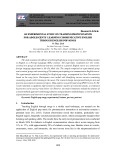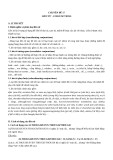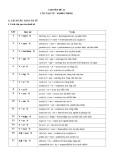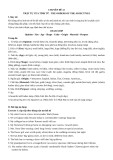
VĂN HÓA https://jst-haui.vn
Tạp chí Khoa học và Công nghệ Trường Đại học Công nghiệp Hà Nội Tập 61 - Số 2 (02/2025)
50
NGÔN NG
Ữ
P
-
ISSN 1859
-
3585
E
-
ISSN 2615
-
961
9
NOMINALISATION IN ENGLISH SCIENTIFIC DISCOURSE:
A SYSTEMIC FUNCTIONAL DESCRIPTION
DANH HÓA TRONG NGÔN BẢN KHOA HỌC TIẾNG ANH: MÔ TẢ CHỨC NĂNG HỆ THỐNG
Vu Thi Mau1,*, Nguyen Thi Quy1,
Nguyen Thi Thanh Tung1, Hoang Tra My2
DOI: http://doi.org/10.57001/huih5804.2025.036
ABSTRACT
This study examines the frequency and function of nominalisation in English scientific discourse (ESD) through an analysis of
33 texts in engineering, biology,
medicine, pharmacy, chemistry,
geography, history, physics, environmental science, business, and information technology. Nominalisation, that is, the
transformation of verbs or adjectives, or other parts of speech into nouns or nominal groups, is a central feature of scientific writing
and a key concept within
Systemic Functional Linguistics (SFL). Employing a corpus-
based approach, this research investigates the role of nominalisation in condensing information,
enhancing precision, and foregrounding key concepts across disciplinary boun
daries. The findings reveal that nominalisation is pervasive in all texts, with
significant variation in its density across disciplines. The highest concentrations are observed in fields such as medicine,
pharmacy, chemistry, and business,
reflecting the distinct communicative objectives and stylistic norms of these domains. Additionally, the study underscores the challenges nom
inalisation poses
for second-language (L2) learners and English as a Foreign Language (EFL) speakers, highlighting its implications
for English for Specific Purposes (ESP) and
English for Academic Purposes (EAP) pedagogy. The results suggest a need for targeted instructional strategies to enhance aca
demic writing proficiency,
particularly in teaching nominalisation as a critical feature of scientific discourse.
Keywords: Nominalisation, English scientific discourse, systemic functional linguistics, abstraction, objectivity.
TÓM TẮT
Bài báo này nghiên cứu tần suất và chức năng của hiện tượng danh hóa trong ngôn bản khoa học tiếng Anh thông qua phân tích 33 văn bản kỹ thuậ
t, sinh
học, y học, dược học, hóa học, địa lý, lịch sử, vật lý, khoa học môi trường, thương mại và công nghệ thông tin. Danh hóa, tức là việc chuyển đổi động từ hoặ
c tính
từ, hay từ loại khác thành danh từ hoặc cụm danh từ, là một đặc trưng nổi bật trong văn bản khoa học và là một khái niệm quan trọng trong ngôn ngữ học chứ
c
năng hệ thống. Sử dụng phương pháp phân tích dựa trên ngữ liệu, nghiên cứu này khám phá vai trò của danh hóa trong việc cô đọng thông tin, nâng cao độ
chính xác, và làm nổi bật các khái niệm chính trong các văn bản khoa học khác nhau. Kết quả cho thấy danh hóa xuất hiện phổ biến trong tất cả các ngôn bả
n
này, với sự khác biệt đáng kể về mật độ sử dụng giữa các ngành. Các lĩnh vực như y học, dược học, hóa học và kinh tế học có tần suất danh hóa cao nhất, phả
n
ánh các mục tiêu giao tiếp và chuẩn mực phong cách đặc thù của từng ngành. Ngoài ra, nghiên cứu còn nhấn mạnh những thách thức mà danh hóa đặt ra đố
i
với người học ngôn ngữ thứ hai và người nói tiếng Anh như một ngoại ngữ, đồng thời nêu bật những tác động của hiện tượng này đối với việc giảng dạy tiế
ng
Anh chuyên ngành và tiếng Anh học thuật. Dựa trên kết quả nghiên cứu, nhóm tác giả đề xuất cần có các chiến lược giảng dạy phù hợp nhằm nâng cao kỹ
năng
viết học thuật, đặc biệt là trong việc dạy danh hóa như một đặc điểm quan trọng của ngôn bản khoa học.
Từ khóa: Danh hóa, ngôn bản khoa học tiếng Anh, ngôn ngữ học chức năng hệ thống, trừu tượng, khách quan.
1School of Languages and Tourism, Hanoi University of Industry, Vietnam
2University of Languages and International Studies, Vietnam National University, Hanoi, Vietnam
*Email: mauvt@haui.edu.vn
Received: 15/11/2024
Revised: 17/12/2024
Accepted: 27/02/2025
































